DESIGN TECHNOLOGY IN THE PRIMARY SCHOOL
Main menu:
ASSESSMENT IN TECHNOLOGY
THE TEACHER
ASSESSMENT OF CHILDREN'S DESIGN AND TECHNOLOGY PROJECTS
( A historical analysis of how teachers may assess their pupil's work.
N. B. The present position of Design Technology in the Primary School may not require anything quite so extensive. )
Before examining the assessment of Design and Technology itself, it is important to look at the overall place of assessment in the wider context of schools in general.
In 1987 the Department of Science and Education set up a Task Group on Assessment and Testing which was asked "to advise on the practical considerations governing assessment within the National Curriculum."
Information gleaned from the introduction to the TGAT report (TGAT 1988-Sections 1 to 6 - R*1) suggests that:-
- "Assessment is at the heart of the process of promoting children's learning";
- "The assessment process itself should not determine what is to be taught and learned" (putting the cart before the horse, testing only the obvious for the sake of gathering information about the progress of pupils), and,
- "It should be an integral component of the educational process, providing both feedback and feed-forward", (not simply driving the teaching strategies and practice in the classroom).
It is therefore worth examining various functions of assessment which have implications as guidelines for assessing Design and Technology work at any level.
For example:- Assessment identifies what a pupil:-
- Knows, understands, can do, i.e. factual evidence on present abilities and progress made so far
The benefits of assessment for the pupils:-
- to improve performance, diagnose individual strengths and weaknesses
- to match work to the classroom and their abilities, to help determine targets and goals for the future
i.e. where to go next, to develop their skills, knowledge and understanding
The benefits of assessment for teachers:-
- to enable them to consider how far their original objectives have been met
- to adjust their teaching approaches accordingly
- to inform interested parties of their pupils' achievements
- to plan continuity and progression
Assessment should also:-
- be an integral part of the learning process
- actively involve pupils in the process of evaluating their own development, particularly at later levels
- address personal, social, physical, practical and cognitive skills, address both process and product
- involve both criterion and ipsative rather than norm-referencing systems, be unobtrusive, relevant, reliable and valid.
Essentially TGAT confined their proposals mainly to assessing "performance" or "attainment" i.e. measuring a child's knowledge, understanding and capacity to reach certain predetermined targets at a particular point in his/her education.
In comparison adapted material from The Department of Education and Science (1989, P6-R*2) shows how they had identified the various types and purposes of assessment as follows:-
FORMATIVE
- ongoing assessment,
- providing information which teachers can use in deciding how a pupil's learning should be taken forward, and giving the pupils clear and understandable targets and feedback about their achievements.
SUMMATIVE
- after the event assessment
- between key stages
- providing overall evidence and information of what the pupil has achieved, knows, understands and can do.
EVALUATIVE
- assessment as a monitor of standards
- giving "comparative aggregated information that can be used as an indicator of where there needs to be further effort, resources, changes in the curriculum etc
INFORMATIVE
- assessment as public relations exercise
- in helping communicate with parents about how their child is doing, with governing bodies, LEAs, OFSTED, and the wider community about the achievements of the school
PROFESSIONAL DEVELOPMENT
- assessment to improve the teachers
- the process of carrying out systematic assessment, recording attainment, monitoring progress and discussing results with others provides a valuable basis for teachers to evaluate their own work and to seek advice where necessary.
All of this looks particularly daunting to both the practising teacher and even more so to the teacher beginner going through a course of initial teacher training, and hoping to become a specialist curriculum coordinator whether for Design Technology or any of the core or foundation subjects.
According to the School Council and Assessment Authority (SCAA 1995 P7-R*3)
"The school should consider its policy on assessment to ensure that it provides a manageable framework for promoting accurate and consistent assessment across the curriculum. Assessment is an integral part of teaching and learning ..... and the assessment policy will inform subsequent medium and short-term planning by clarifying the school's approaches to :-
1. The identification of clear learning objectives
2. Show how and when children's progress will be assessed
3. The use of assessment to match work to the learning needs of children"
As the outcome of set tasks given to pupils the National Curriculum Council suggest that the evidence of attainment will come in two forms:-(NCC 1991 P13-R*4)
- Transitory - available only to the teacher at the time of observation (I heard the pupil say this, I saw the pupil do this
- Permanent - as a physical outcome of the designing and making process (A piece of "writing, drawing, model, prototype", other form of end product)
In 1992 when there were four Statutory Attainment Targets for Technology the School Examinations and Assessment Council produced a useful booklet (1992-R*5) on assessing children's work in Design and Technology showing the work of seven children at Key stage 1 and giving examples of how teachers might make assessment of their abilities or capabilities in Technology and other subject areas.
In the same year the Consortium for Assessment and Testing in Schools (CATS) under contract to SEAC produced a Teacher's Handbook on Technology Standard Assessment Tasks (SATS) at Key Stage 1 (1992-R*6) and four booklets (1992-R*7,8,9,10) giving guidelines for assessment of children's Technology work for projects on Shelters, Protective Headgear, Setting Up Shop and Greetings Cards.
By 1992 these examples of Technology Tasks were essentially optional assessment materials that could help teachers make assessment processes more understandable when children followed the Design and Technology process. Each of the booklets gave an indication of which of the four Statutory Attainment Targets or strands was the focus for the project and what teachers should do and look for in the assessment of the children's work.
Despite the fact that there are now only two Statutory Attainment Targets for Technology much of the material on assessment guidance in these examples is still relevant. Once the child has completed a task,teachers could use their "gut feelings" as an initial judgement, placing the work within a level for an AT using their own experience and understanding of the TGAT scale of Attainment Target levels compared to age range (figures 1 and 2).
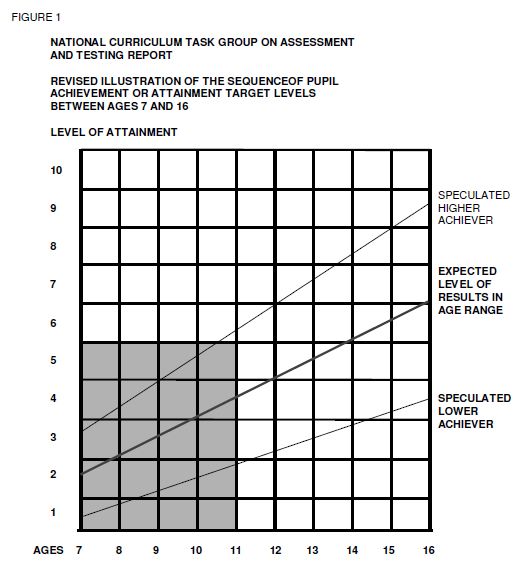
The straight line graph shown above in Figure 1 (a modified version of that devised by the Task Group for Assessment and Testing ) (TGAT 1988 P9-R*11) shows the 10 levels of expected attainment that pupils may reach when compared against their age ranges of 7 to 16. This obviously covers the ability range that may be found at Key Stage 2 or Junior school (shown in the shaded area) and their expected progression through Key stage 3 in their Secondary school education.
A system of representing children's development as a straight line graph is essentially problematic in that every pupil develops at a different pace, sometimes in leaps and bounds with periods where little or no progress appears, whilst at other times racing ahead of their peers.
Essentially it is a basic model, in technological terms a simplified version of reality, to be used as a starting point for showing the sequence of achievement or attainment levels that the gifted, average, and slow learner may or may not reach at a particular age in their education.
The original diagram in the TGAT report has been modified slightly for clarity and from the shaded area it appears that Junior School teachers need to concentrate on Attainment Levels 1 to 5 of ability range when devising their schemes of work in all subjects of the National Curriculum.
In the "Post-Dearing" National Curriculum document for Design and Technology (1995 P14-15 -R*12) these Attainment Target criteria guidelines are clearly defined, indicating a style of criterion-referencing that compares performance and attainment against predetermined expectations or specified criteria for a particular age group.
Ipsative-referencing in comparison compares a child's present performance against that same child's previous performance, gauging an individual's progress over a period of time.
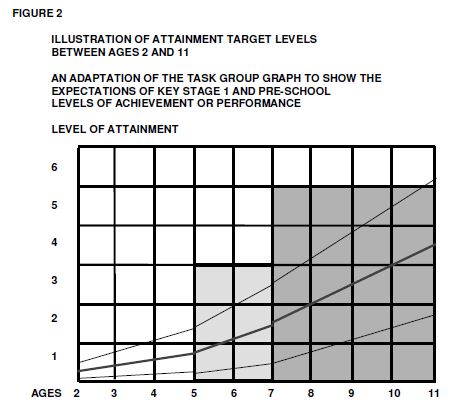
In this second graph, which shows the same larger shaded area for Key Stage 2 as in Figure 1, an attempt has been made to show a more realistic curved set of lines in the graph representing the progress of the gifted, average and slow learner from the age of 2 through pre-school learning and Key Stage 1. (the smaller shaded area.)
This indicates that the Infant school class teachers need to concentrate on Attainment Levels 1 to 3 of ability range when devising their schemes of work in all subjects of the National Curriculum. Again it can be seen that in the Technology document the AT guidelines are already clearly defined, and need to be examined in detail.
The child's achievements can then be narrowed down by referring more closely to the statements of attainment expected for the age of the child and the skills of Designing (AT1) and Making (AT2) hopefully found in the child's project work.
Deciding the exact level of attainment that a child has reached is difficult unless the teacher has a good understanding of these two new attainment targets laid down in the "Post-Dearing" National Curriculum document for Design and Technology.
Many key-words and phrases can be found there that may assist in more accurate assessment of the actual Attainment Target and Level that has been reached by each child by determining whether or not the project work exemplifies or reflects these particular features.
AT1 DESIGNING
Level 1 generate ideas
- shape, assemble, rearrange materials and components
- use pictures and words
Level 2 generate ideas
use experience of materials and techniques
use models and pictures
Level 3 generate ideas
recognize conflicting requirements
make realistic suggestions
use labelled sketches to show detail
Level 4 generate a number of ideas
gather information independently, evaluate work as it develops
illustrate alternatives using sketches and models
Level 5 generate ideas drawing on external sources
understand familiar products
clarify ideas through discussion, drawing modelling
evaluate ideas
show understanding of function and resource restraints
AT2 MAKING
Level 1 explain what they are making
describe materials being used
use given techniques to shape, assemble and join
Level 2 range of materials, tools and techniques
use tools safely
make judgements on outcome of their work
Level 3 order their work
purposeful choice of tools, materials and techniques
use simple finishing techniques
cut and shape materials and components
detail changes made to original ideas
Level 4 step by step plans of stages of making
measure, mark out and cut simple forms
show increasing accuracy and quality of finish
identify good and bad points in their work
Level 5 work from plans they have produced
modify where necessary if first attempt fails
increasing precision and control
evaluate their products,
compare with intentions and suggest improvements
There are therefore numerous interlinked questions that teachers may need answers to, in order to provide an indication of a child's Technological Capability at a particular level. However, despite the increasing complexity of these key words and phrases shown above there are identifiable similarities that occur at all levels.
They should be assessing:-
ATTAINMENT TARGET 1 DESIGNING SKILLS
1. Clarifying the task
2. Generating ideas
3. Developing and communicating ideas
4. Hypothesizing, proposing and planning how to make the end product
5. Testing and evaluating ideas as they proceed
ATTAINMENT TARGET 2 MAKING SKILLS
1. Knowledge, choice and understanding of various materials
2. Proficiency in the handling of various tools
3. Safety aspects of their work
4. Suitability, ergonomic and aesthetic restraining factors
5. Accuracy of finish in the final product
6. Testing, evaluating and suggesting further improvements
A very comprehensive list of these two broad areas of Designing and Making skills is given by the School Council and Assessment Authority (SCAA 1995 P8-17-R*13) but Skills and Attitudes developed through Design and Technology were earlier outlined by Cyril Gilbert (1987 P8-9-R*14) in the LOOK project for Primary Technology.
There is still some expectation that children are able to find their own need, opportunity, problem or task for designing and making activities, and that they should also carry out some evaluation and testing of their ideas and end products but teachers really need to concentrate on assessing various aspects of the separate Designing (AT1) and Making (AT2) components of the activities.
FIG 3 below
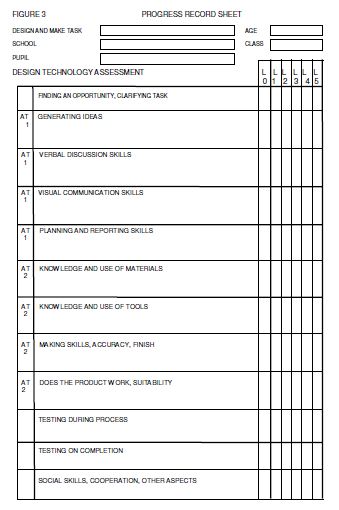
Figure 3 shows a grid that could form a starting point for assessing pupils work in Design and Technology, by isolating four major areas to look out for in each of the two Attainment Targets. The grid also includes the elements of clarifying the task, ongoing evaluation and testing on completion.
The grid could be used by the teacher to outline the actual task and expectations of outcome during the design and make experiences, before the children are given the task.
This way there is an indication of what the teacher hopes the children will achieve and what levels of attainment may be reached.
The left hand areas set out on the assessment grid could be used in a fairly flexible way to record comments on the efforts and results of individual children right across both Key stages 1 and 2. It also allows a system to be devised for more accurately estimating the level of attainment reached from levels 1 to 5 in the columns on the right hand side.
The L0 or level zero column is meant to be used where a child has not been involved in or made a contribution to that particular part of the design and make process.
A reception class teacher who may be guiding children through the focussed practical task of making an animal mask may be concentrating on the processes of manufacture and use of materials rather than the designing aspect
With this particular age of children who may not have adequate conceptual and manipulative abilities to follow the full design and make process, comments in the progress record and assessment grid in figure 3 may read as follows:-
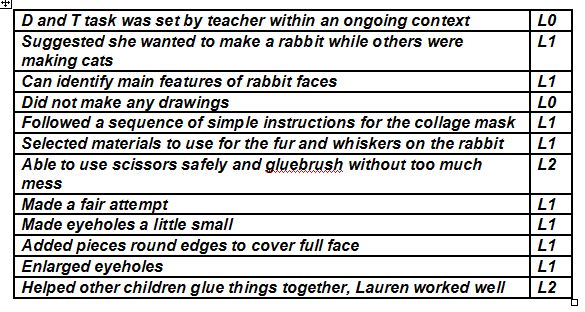
In comparison a teacher working with a class of top juniors on the context of bridges may record the following information sequentially on the grid and selecting the AT levels accordingly.
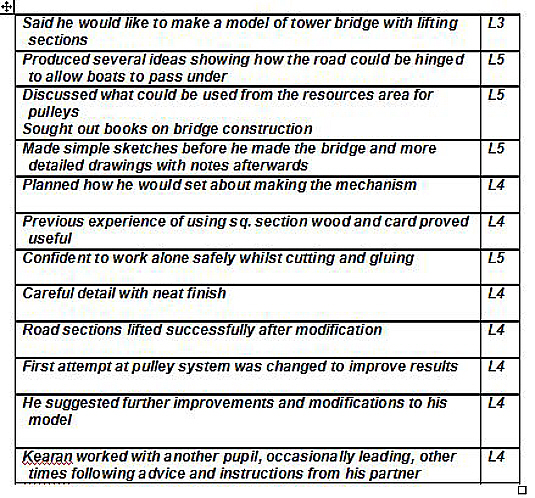
The assessment grid shown in Figure 3 is not meant to be used in isolation from other procedures for monitoring the progress of pupils that have been adopted across the school or the LEA.
There may well be several other systems ongoing at any one time in order that a complete and comprehensive record is kept of each child's progress across the school.
A variation on the grid shown in Figure 4 below may be adopted where the assessment of Design and
Technology work is a natural element within a simpler framework showing progress in all of the subjects across the primary curriculum, at a glance.
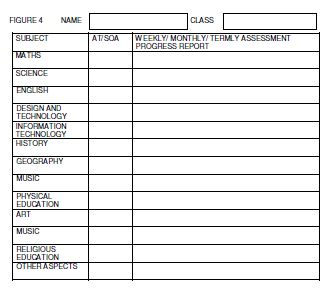
Greater emphasis can be given to the individual core or foundation subjects by giving them more space in the sections of the grid, and the more frequent and regular the monitoring, the more information and data that is obtained on the individuals concerned.
In this way it becomes easier to identify the exact Attainment Target or level of ability a child has reached in Design and Technology compared to the National Curriculum standards and therefore possible to pass more accurate information on to parents, the school in the next key stage, or to a school in another part of the country if a child moves away from the area.
Whilst it is worth noting that in its present form Design and Technology is a relatively new and developing subject, particularly in the Primary School, and having had two major revisions of the statutory orders, the new requirements for Key Stages 1 and 2 give an indication that whereas formal assessment is not compulsory, it should be considered to be "essential" rather than "desirable" perhaps for other reasons.
In a recentlly published Guide to the National Curriculum there are statements that reinforce this argument in the section on planning, assessing, recording and reporting. (SEAC 1996-P9-11-R* 15)
Namely:-
- "At the end of a key stage, teachers are required, in some subjects, to make a judgement about pupils' attainment"
- "Decisions on how to record pupil achievements and on the selection and keeping of evidence of pupils'work are matters for professional judgement".
- "Teachers should keep records and evidence that help them track pupils' progress and build up their knowledge of individuals."
The assessment grid shown in Figure 3 will be particularly useful to assess each child's work in Designing and Making Assignments, and perhaps parts of the same grid could also be used for Focused Practical Tasks and the Investigation and Evaluation of simple products. (The three essential types of activity that the Design and Technology curriculum should include.)
However the assessment grid could possibly provide a way of not only assessing, but also recording and reporting on the progress of pupils, simultaneously.
Using the grid creatively could provide the instrument for evidence of a pupil's progression, performance and attainment in Design and Technology across an academic year, and therefore be an important component of a pupil profile in an annual report (which is a stututory requirement) or end of key stage report (also a statutory requirement) given to parents, showing in some detail their child's strengths and weaknesses.
Whatever method of assessment of Design and Technology is adopted across the school, whether or not it includes some features of recording and reporting, it should match closely the needs of the staff and pupils.
BIBLIOGRAPHIC SOURCES OF REFERENCE (As quoted in assessment document above)
R*1 National Curriculum Task Group on Assessment and Testing Report
Department for Education and Science (Main Report) 1987 December
No Ref or ISBN
R*2 National Curriculum From Policy to Practice
Department of Education and Science 1989
HMSO Dd 80540791989 ISBN 0 85522209 3
R*3 Planning the Curriculum at Key Stages 1 and 2
School Curriculum and Assessment Authority 1995
ISBN 85838 051 0
R*4 Issues in Design and Technology,
Technology in the National Curriculum in Key Stages 1 and 2
National Curriculum Council 1991
ISBN 1 872676 76 6
R*5 Children's Work Assessed,
Design and Technology and Information Technology
School Examinations and Assessment Council 1992
Ref. A/024/B/91
R*6 Technology Standard Assessment Tasks, Teachers Handbook
Consortium for Assessment and Testing in Schools
School Examinations and Assessment Council 1992 (No ISBN NO)
R*7 Technology Te 1-4 Shelters for Plants and Animals
Consortium for Assessment and Testing in Schools
School Examinations and Assessment Council 1992 (No ISBN No)
R*8 Technology Te 1-4 Protective Headgear
Consortium for Assessment and Testing in Schools
School Examinations and Assessment Council 1992 (No ISBN No)
R*9 Technology Te 1-4 Setting Up Shop
Consortium for Assessment and Testing in Schools
School Examinations and Assessment Council 1992 (No ISBN No)
R*10 Technology Te 1-4 Cards as Greetings
Consortium for Assessment and Testing in Schools
School Examinations and Assessment Council 1992 (No ISBN No)
R*11 Task Group on Assessment and Testing Report A Digest For Schools
Department for Education and Science 1988 March
HMSO Dd 8950034 EDUC J0239NJ
R*12 Design and Technology in The National Curriculum
Department For Education 1995
HMSO ISBN 0 11 270888 9
R*13 Key Stages 1 and 2 Design and Technology the New Requirements
School Curriculum and Assessment Authority 1995
ISBN 1 85838 048 0
R*14 A Guide to Primary Technology Policy (The LOOK Project)
Cyril Gilbert, Oliver and Boyd 1987
ISBN 0 05 004178 9
R*15 A Guide to The National Curriculum
School Curriculum and Assessment Authority 1996
ISBN 1 85838 082 0